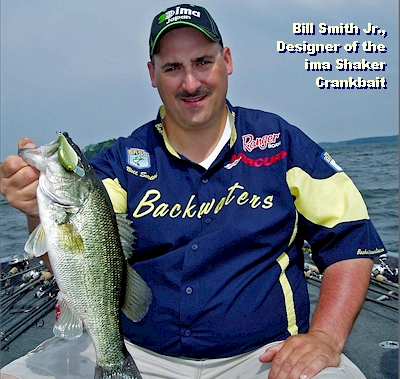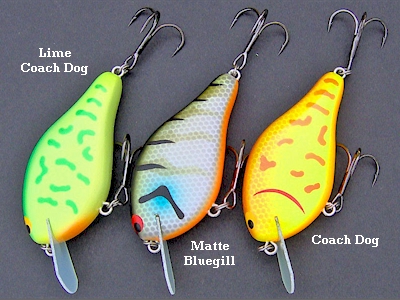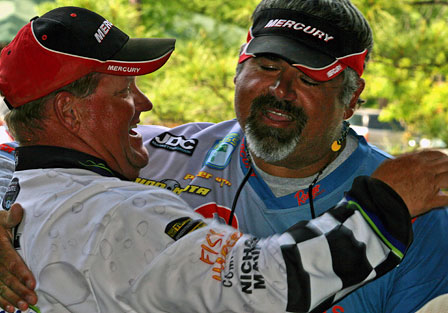
Welcome! To the ima EMAILER ~ May 2008 Issue
The IMA EMAILER brings you news from IMA pro staff members Bill Smith, Fred Roumbanis, Michael Murphy and other Ima pro staffers across the USA and worldwide.
| Good News! This month’s emailer is all about the ima Shaker crankbait. |
Hello. It is BASSMASTER Elite Angler Bill Smith here and I am proud to say that I designed the ima Shaker for you. It is a small, flat-sided, shallow-diving crankbait with a thin computer board lip. At 2-3/4 inches long, the Shaker weighs 3/8 oz and runs 3 to 5 feet deep. With its internal weight transfer system, the Shaker let’s one reach unprecedented casting distances with a crankbait of this kind.
I designed the ima Shaker to improve upon and replace the flat-sided balsa crankbaits that are regional favorites in my section of the country, the southeast USA. I grew up fishing balsa crankbaits for over twenty years, and I know them well. I know what are balsa’s merits as well as balsa’s weaknesses.
Since the Shaker is the latest improvement upon and replacement for balsa, I feel it is appropriate to first share a few words with you about the Shaker’s predecessors – balsa crankbaits. So first, here is a bit of the interesting history of balsa cranks…
A Little Background on Balsa Crankbaits
Originally, going back over forty years, the Big O is one of the first milestones. The original Big O they say was whittled by hand out of balsa wood by Fred Young of Oak Ridge, Tennessee in the late 1960’s – and they say that is the start of balsa crankbaits for bass in the USA. Mr. Young was not the only one whittling balsa crankbaits in the region 40 years ago, but the Big O is the one to achieve some sort of national fame and lasting historical significance. It really only did that because it was reproduced in hard plastic during the early 1970’s by Cotton Cordell and quickly sold by the millions. But my point is that as far back as 40 years ago, hand-carved balsa crankbaits were popular and prized baits across the south even then.
Other early and legendary names in balsa crankbaits include Jim Bagley, Lee Sisson and certainly Rapala. As I understand it, these were on the scene since the early to mid-1970’s. Today, these names still have national and worldwide recognition. When it comes to balsa crankbaits, many bass anglers may be familiar with those names.
What’s not so well-known outside the region is the ongoing refinement of locally hand-crafted balsa crankbaits by lure builders across the region and states of Virginia, West Virginia, Tennessee, Kentucky, Alabama, Georgia, Indiana, Ohio, Illinois and parts thereabouts. This is all considered balsa crankbait country.
Especially within the last twenty years or so (since the mid-1980’s), many of the locally-produced balsa crankbaits used across this region have been refined to a fine art. This is woodworking and furniture-manufacturing country, where whittling’s a pastime and a handful of guys here have the modern toolshops and wherewithal to produce high quality balsa crankbaits.
There was an old gentlemen from whom I remember my Dad would buy hand-crafted wood topwater lures. This fellow worked in a furniture factory, and made lures in his spare time. This old gentleman did not even fish, but he paid close attention to the constant feedback from the anglers who were his customers, like my Dad. He’d make the changes they suggested to him, thereby improving his topwater products. Both the anglers and the artisan took a sense of pride from this. Over time, he gained quite a local reputation and following for well-made, fish-catching topwater baits. Now take someone with that woodworking skill and love, with a little tool shop, who takes pride in their work and also likes to fish, and that’s what’s been happening for the past twenty years in this part of the country with regionally-produced balsa crankbaits.
You can think of what’s going on here as being similar to what’s gone on with swimbaits on the west coast. For the longest time, swimbaits were a local phenomena, designed, developed, locally-made and used on the west coast as an effective way to catch the bass there. Of course, we see today that swimbaits work everywhere, not just California.
Likewise, balsa crankbaits made in and used across the southeast, have been local favorites for the longest time.
But as we’ve found with swimbaits, these balsa crankbaits (and now the ima Shaker) will also work everywhere, not just in the local region, but everywhere across the USA.

As a Bassmaster Elite Series pro, including all the places I’ve traveled, all the water I’ve fished across the country, 95% of the places I’ve been from coast to coast and border to border, these balsa crankbaits (and now the ima Shaker) have worked for me.
And I can tell you that there isn’t a Bassmaster Elite pro who I know who doesn’t have a box full of flat-sided, hand-made custom balsa crankbaits on his boat, ready to use at every event across the country. These are baits that are hard to get, that have taken years for many of the pros to amass the boxfuls they’ve got. Every pro has them and knows that at any time or any place, flat-sided balsa crankbaits can prove effective.
Introducing the ima Shaker
Now that I’ve gotten you interested to try balsa crankbaits, let me tell you that the new ima Shaker is an improvement upon and replacement for a certain kind of balsa bait – the flat-sided crankbait.
The flat-sided balsa bait gained a following in the Tennessee/Alabama market years ago. It’s real strong on the Tennessee River chain, and also on Ohio River system, where they seriously refined the trend of the smaller flat-sided baits to imitate smaller shad so prevalent there. Over time, this flat-sided crank spread throughout the southeast market.
The ima Shaker is the very latest flat-sided crank that matches this most common smaller size of shad.
The Shaker has a very lifelike baitfish appearance. With the flat sides, the Shaker imitates more of a shad than the typical fat, bulbous, round-bodied crankbait. The flat-sided Shaker looks like a shad and has a more realistic profile. Yet it still has the characteristic wide wobble of a balsa bait.
However, the ima Shaker is not balsa. The Shaker is a new injection-molded hard plastic bait with a computer board lip. The Shaker is designed to have all the merits but none of the weaknesses of balsa.
Some of the big disadvantages of balsa crankbaits versus the ima Shaker are:
| Good Quality Balsa Crankbaits |
Ima Shaker |
| They can’t take but one good hit on a rock or a log or the diving bill may loosen from the surrounding softer balsa lip slot. |
The main factor is durability, the lip stays in. The lip slot is molded (not hand-cut) with a very tight tolerance that helps fortify and secure the computer board lip within the surrounding, tightly-fitting hard plastic. |
| The line tie eye and hook hangers are screwed-in, slots for lips and belly weights are drilled and then glued by hand, not always perfectly. |
The component parts, hangers, eyes, weighting system and lip are precisely fitted into injected-molded bodies, with little to no possibility of being off. |
| The hook hangers or front line tie eye can loosen up under a little too much pressure or pull right out of balsa. |
The hook hanger and line tie are molded in “figure-eight” stainless wire. Not likely to ever pull out under normal fishing conditions. |
| A balsa body will often break toward the thinner tail section, especially if a fish is hooked on the tail treble only. |
The hard plastic body is not likely to ever break under normal fishing conditions. |
| Balsa is a light wood and especially with the flat sides, hard to cast. It often waffles in the air like a potato chip, falling all too short, causing nasty line snarls or backlashes. |
The Shaker features an internal weight transfer system allowing the bait to fly incredibly far distances on the cast with greater accuracy and line control. |
| No two are ever quite the same, due to the natural inconsistencies of each piece of wood, plus the line tie, hangers, belly weights, lips are not always consistent. For any 12 balsa baits, you tend to find 2-3 are truly good and will catch most of your fish. Another 6-8 may only ever be average catchers, and 2-3 may never work well. |
ima has eliminated this problem of inconsistent baits. Every Shaker will run true straight out of the package. The buoyancy rate and action will be the same each time. We took a long time to get the ima Shaker perfect, based on decades of experience using balsa. We made the prototype Shaker the best we could – and precision injection-molding makes it consistent for every single bait. |
| The good ones are hand-made and always hard to get. Often you have to be a pro or know the lure builder to have any chance. If you place an order today, the waiting list may take from one to two years for some. |
The ima Shaker is readily available now at fine tackle shops across North America. Anyone can get the Shaker, a lure similar to the hard-to-get flat-sided balsa cranks that most of the top pros have a boxful. |
| Because they are so fragile and hard-to-get, most anglers avoid using their best balsa cranks in heavy cover, the very places that fish favor most. |
The ima Shaker can be fished through all difficult cover – around docks, rocks, stumps – that would utterly destroy a balsa crankbait. The bodies won’t break or chip and loose chunks (like balsa does) when they flare off of wood or a rock. |
| Good quality balsa cranks are expensive. |
The Shaker costs less than good hand-made balsa crankbaits. The Shaker is a GREAT BUY when you think that you are spending more for a hand-made balsa bait that you don’t know will run true and balsa has the potential of getting destroyed quickly. |
As you can see above, the Shaker is designed to imitate a balsa bait, and improve on it. The advantages of the Shaker over balsa are many – more durable, lasts longer and with its internal weight transfer system, is easier and more accurate to cast than balsa.
Because a flat-sided balsa crank is such a poor casting lure, a lot of time you can only use one with 6-8 pound spinning gear to have any hope of casting a decent distance. Even then, you are probably talking about a 40 foot cast with a balsa crank on light line spinning gear versus a 60 foot cast with the ima Shaker on 10-15 pound baitcasting gear. That heavier grade of baitcasting gear could pull a balsa crank apart like it was cotton candy – if you could even cast a balsa bait on such gear (you really can’t).
So you’re comparing 60 feet with the Shaker on a 10-15 pound baitcaster versus 40 feet for balsa on 6-8 lb spinning gear.
That’s 20 feet longer that the Shaker is in the water, attracting fish, on every cast. That’s significant and equates to more fish caught due to the Shaker staying longer in the strike zone.
So not only is the Shaker more durable, able to withstand the force of heavier tackle, but also casts much further (and accurately) and can be fished in dense cover that fish love.
Color Patterns
The hard-plastic injection-molded nature of the ima Shaker is a radical new departure from balsa crankbaits – but the finishes and color patterns are not.
The ima Shaker finishes make them look like they’re balsa cranks. When painted and finished, it’s hard to tell at first whether the Shaker is plastic or wood.
We’ve tried to stay true to the well-known regional color patterns used on hand-made balsa cranks across the southeast, plus we’ve stayed with the unique names used for these regional color patterns.
The guys in the southeast who throw balsa cranks will be familiar with these names and colors. They are derived from favorite colors of parochial balsa baits – like the color Plemmons is one of the most famous. That has been around for ages, and everyone in the region knows what color it is just from the name – Plemmons.
Besides Plemmons, Coach Dog and Dolphin are probably the three most famous colors in the region.

Another unique color is named Hortin as well as Chartreuse Hortin. These are names that have never changed for ages. We felt a need to make the names and colors of the ima Shaker very familiar to the guys in the southeast in balsa bait country. At the same time, it’s going to be a little education or learning experience for anglers in other parts of the country. But don’t worry, you will get familiar with these colors quickly. When you catch a few fish on them, they’ll become your favorites too.
Another color is Lime Coach Dog. If you don’t know what coach dog refers to, it is a Dalmatian. They were trained in days of yore to run alongside and accompany carriages or coaches on the road. So the Coach Dog lure color has Dalmatian spots all over it.

One thing that Lime Coach Dog, Matte Bluegill and Coach Dog (shown above) have in common is that they are early spring time colors. I feel why they work best then is that they really imitate bluegill that are the prevalent forage up shallow then. I could never figure out any rhyme nor reason why, but Coach Dog always seems to work better when the bass first come up shallow in the spring whereas Lime Coach Dog tends to hold up and lasts a little longer through the latter part of spring. Matte bluegill is always effective as long as small bluegill abound.

Plemmons and Rootbeer (shown above). These are two solid shad colors. They excel whenever there are lots of shad around. Now, root beer always seems to work fished right in the thick of the shad. You may wonder about that, because it does not resemble a shad color. In its case, you don’t try to match the hatch. You try to stick out from the rest, and bass hone right in on it.
Some of the other colors – Black Chartreuse for instance, are old familiar standbys. A few of the colors, such as White Shad and Alabama Shad, are simply solid, universal shad colors. Don’t leave home without them.
We talked about color choices above being based on certain seasons or prevalent baitfish. Color choice can also be based on water clarity:
- Clear water. Matte Bluegill, Hortin and Rootbeer are reliable.
- Dirty water. Try Dolphin, Black Chartreuse and Coach Dog. There is a little bit of rattle sound which helps. Fish pick up on that little noise, plus the crankbait’s vibration can call them in from a decent distance in dirty water.
- Stained water. The most productive water color, better than either clear or dirty water. For shallow-running flat-sided crankbaits, I always like to have some stain. A wide variety of colors will work in stained water depending on the season, the prevalent bait and other factors.
Plemmons is probably the favorite color of many because Plemmons works in any water color. So always give Plemmons a try.
Where and When to Use the ima Shaker
The ima Shaker is a shallow diver, running 3 to 5 feet deep.
Therefore, where and when it works best is in shallow water, no more than eight feet deep.
Simply, where you have bass in a water depth of five foot (less than 8 foot), that’s the strike zone within which the Shaker is going to work.
- Spring and Fall. Bass are most often up in shallow water in the spring and fall. So the Shaker will work anywhere there’s shallow water during spring and fall. Especially in stained or muddy water, fish like to stay up shallow for a longer part of the season.
- Summer. Once you get into the summer season, you need to dissect your lake or reservoir into the main lake body versus the side creeks, the upper river arms or tributary type areas.
In the main lake body or big basin type areas, bass tend to move off the banks and they occupy deeper water beyond the effective range of a shallow-diving crankbait in summer.
However, there are always some bass shallow all through the summer, especially if you go up into a river arm, the back end of a creek, an inflow end of a reservoir, or anywhere with a current situation, you can produce shallow bass on the Shaker throughout the summer.
On reservoirs where water is routinely drawn to generate electricity or for whatever purpose they pull water, bass tend to move from deep havens to nearby shallow areas for the duration that moving water flows through those shallows. So even the main lake, when they pull water during the summer months, can have shallow bass willing to belt the Shaker at those times.
- Winter. As in summer, many bass tend to pull into deeper areas off the banks in winter, and in the colder months of the year, bass tend to want a tight-wobbling crankbait anyway. The Shaker is more wide-wobbling.
For those who live up north in smallmouth country or wherever one bass species is more prevalent, you’ll be glad to know the Shaker appeals equally to all three species of bass, largemouth, smallmouth and spotted bass.
The swimming action of the ima Shaker is very unique. It took a lot of time until I got the action perfect. With all that’s written above, there’s just no way I can truly describe how well this crankbait wiggles through the water. You really need to get one and go watch it swim to believe it. Once you see that, you’ll want to use the Shaker all the time.
You can really hit rocks, stumps, shallow structure and not get hung up. Usually, when a crankbait has a real wide wobble, the hooks swing out from side to side and grab everything – but that’s not the case with the ima Shaker. You can go right through tree tops, stump fields and rock jumbles, and unless the bait gets wedged, just give a little slack, and it’s going to float up and over most anything down there.
Okay, here’s one last good tip for when and where to use the Shaker that I’ll tell you and then say goodbye. One thing I do a little different when shad are up on the surface away from the bank, over relatively deep water, the wide wobble of the Shaker swimming through the shad schools will break up the shad, cause the shad to flush, and that can provoke a strike. This little trick can work when bass are present, but not very aggressive on topwater lures. The fact that the Shaker’s a few feet under the surface, and busting up the shad schools as it comes through them can be effective.

Thank You! For Reading the ima EMAILER
Ima’s a big name in Japan where Ima is known for its hardbaits. Ima is now making it’s debut in the U.S. market.
U.S. bass pros Bill Smith, Michael Murphy and Fred Roumbanis have helped IMA design new hardbaits for the USA.
We’ll send you stories and tips from Fred, Bill and Michael every month.


























